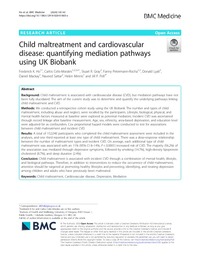Mostrar el registro sencillo de la publicación
Child maltreatment and cardiovascular disease: quantifying mediation pathways using UK biobank
| dc.contributor.author | Ho, Frederick | |
| dc.contributor.author | Celis-Morales, Carlos | |
| dc.contributor.author | Gray, S.R. | |
| dc.contributor.author | Petermann-Rocha, Fanny | |
| dc.contributor.author | Lyall, Donald | |
| dc.contributor.author | Mackay, Daniel | |
| dc.contributor.author | Sattar, Naveed | |
| dc.contributor.author | Minnis, Helen | |
| dc.contributor.author | Pell, J.P. | |
| dc.date.accessioned | 2020-10-26T21:09:38Z | |
| dc.date.available | 2020-10-26T21:09:38Z | |
| dc.date.issued | 2020 | |
| dc.identifier.uri | http://repositorio.ucm.cl/handle/ucm/3125 | |
| dc.description.abstract | Background: Child maltreatment is associated with cardiovascular disease (CVD), but mediation pathways have not been fully elucidated. The aim of the current study was to determine and quantify the underlying pathways linking child maltreatment and CVD. Methods: We conducted a retrospective cohort study using the UK Biobank. The number and types of child maltreatment, including abuse and neglect, were recalled by the participants. Lifestyle, biological, physical, and mental health factors measured at baseline were explored as potential mediators. Incident CVD was ascertained through record linkage after baseline measurement. Age, sex, ethnicity, area-based deprivation, and education level were adjusted for as confounders. Cox proportional hazard models were conducted to test for associations between child maltreatment and incident CVD. Results: A total of 152,040 participants who completed the child maltreatment assessment were included in the analyses, and one third reported at least one type of child maltreatment. There was a dose-response relationship between the number of maltreatment types and incident CVD. On average, each additional type of child maltreatment was associated with an 11% (95% CI 8–14%, P < 0.0001) increased risk of CVD. The majority (56.2%) of the association was mediated through depressive symptoms, followed by smoking (14.7%), high-density lipoprotein cholesterol (8.7%), and sleep duration (2.4%). Conclusion: Child maltreatment is associated with incident CVD through a combination of mental health, lifestyle, and biological pathways. Therefore, in addition to interventions to reduce the occurrence of child maltreatment, attention should be targeted at promoting healthy lifestyles and preventing, identifying, and treating depression among children and adults who have previously been maltreated. | es_CL |
| dc.language.iso | en | es_CL |
| dc.rights | Atribución-NoComercial-SinDerivadas 3.0 Chile | * |
| dc.rights.uri | http://creativecommons.org/licenses/by-nc-nd/3.0/cl/ | * |
| dc.source | BMC Medicine, 18, 143 | es_CL |
| dc.subject | Child maltreatment | es_CL |
| dc.subject | Cardiovascular disease | es_CL |
| dc.subject | Depression | es_CL |
| dc.subject | Mediation | es_CL |
| dc.title | Child maltreatment and cardiovascular disease: quantifying mediation pathways using UK biobank | es_CL |
| dc.type | Article | es_CL |
| dc.ucm.indexacion | Scopus | es_CL |
| dc.ucm.indexacion | Isi | es_CL |
| dc.ucm.doi | doi.org/10.1186/s12916-020-01603-z | es_CL |



